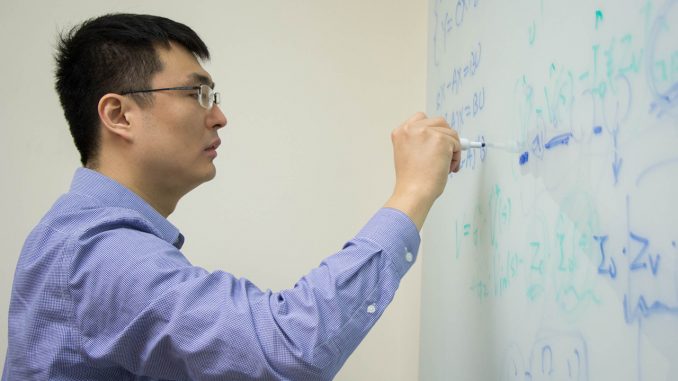
Andrew Decker was working on homework in a Weiss Hall classroom when the lights suddenly went out on Sept. 26.
“They came back on and I thought somebody must’ve hit a switch. Then they went back off again,” said Decker, a freshman political science major.
Only the emergency power lights were on, the elevators were down and he had no way out besides walking down seven flights of stairs, he said.
At the same time in the Science Education and Research Center, Xiaonan Lu, assistant professor of electrical and computer engineering, was on a conference call and was suddenly disconnected. The loss of power helped prove Lu’s point: he was presenting a United States Department of Energy-funded project to help increase power grid resiliency.
With this new technique, power grids, interconnected networks for delivering electricity from producers to the businesses and consumers, can be built to adjust their output levels to compensate for a power surge and minimize outages.
“I let them know that we need to consider power outages and how to mitigate the impact and how to be more resilient, and suddenly I was disconnected,” Lu said. “That’s really not only embarrassing, but it’s bad. Power outages are out there, and we need to do something.”
Lu is working on a collaborative research project, led by Argonne National Laboratory, a science and engineering research laboratory, to create a more reliable and resilient distribution grid by using solar energy. He’s working with professors at Illinois Institute of Technology, Southern Methodist University, and United Technologies Research Center to adjust the boundaries of the microgrids so that they can adjust the amount of energy needed to output based on the situation.
“So even though there is a power outage, we try to have uninterrupted power supply,” Lu said.
During a power outage, microgrids use various sources of energy and “smart switches” to isolate the problem so that as much power as possible can be maintained, Lu said.
Outages can cost about $150 billion across the U.S. annually in spoiled food, lost productivity and other costs, according to data from the Galvin Electricity Initiative.
“In terms of resiliency, it’s a new concept compared to the more traditional ones like stability or reliability,” Lu said. “We need to do more to ensure that the system is more flexible and more resilient. That is our main focus.”
Caroline Burkholder, sustainability manager at the Office of Sustainability, said Temple updated its 2019 action plan in accordance with a 2016 Climate Leadership Statement, a commitment incorporating carbon neutrality and strategies to address change.
“They said that you have to incorporate this resiliency planning because everyone has figured out it’s not a matter of stopping climate change, it’s a matter of dealing with it’s known effects” she added. “It is important not only to reduce our carbon footprint and to be purchasing large amounts of renewable energy, but also as a public institution within the city of Philadelphia, we need to be looking at how we can at least match the city’s commitment.”
Lu’s work will hopefully help to prevent outages like the one that Temple experienced from occurring, he said.
“We know that some people are saying that we can use microgrids to aggregate distributed energy sources at a local level,” he added. “This is relatively mature technologies that we can use, and in the meantime, we are trying to advance this technology to talk about more.”
“The work he’s doing is certainly important,” Decker said. “It would definitely be good for my time and help me get essays written.”



Be the first to comment